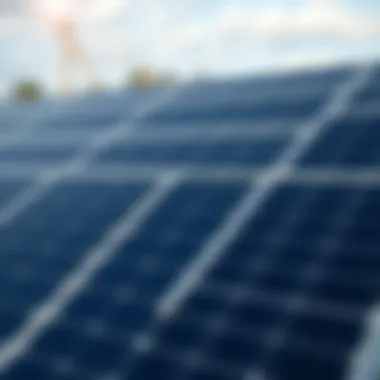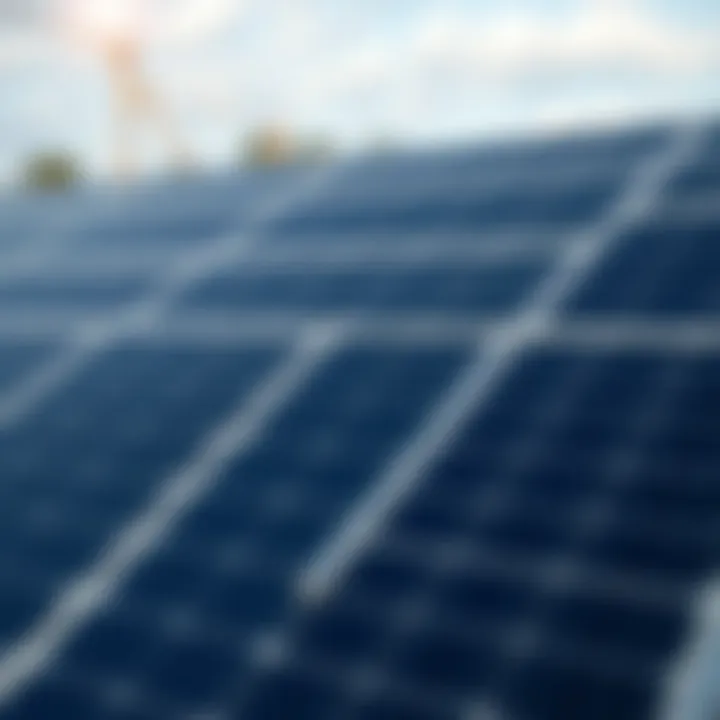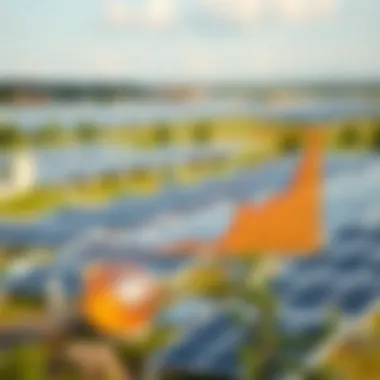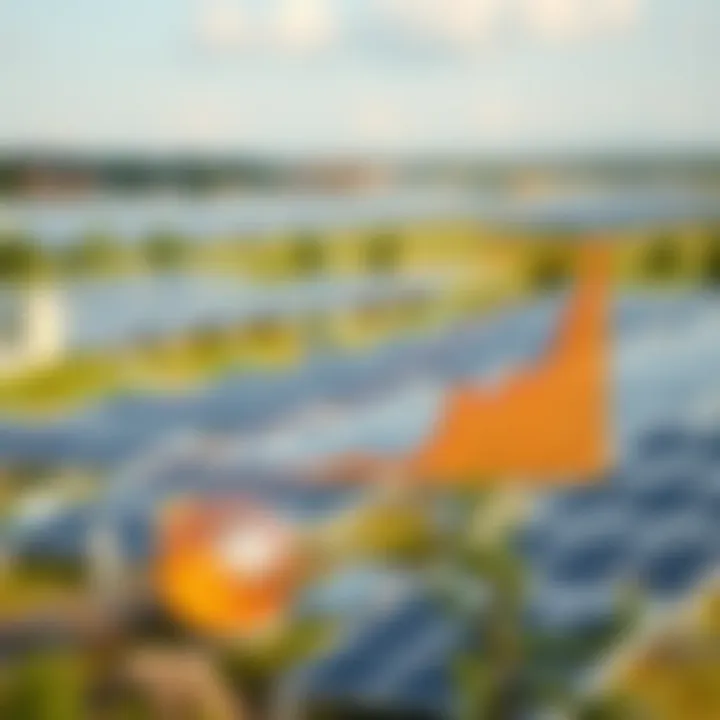Analyzing Costs of Solar Panels: Key Insights


Investment Dictionary
Before diving into the nuances surrounding the cost of solar panels, it’s critical to grasp some foundational terminology. Having a strong understanding of these terms will empower you to navigate the solar energy landscape with confidence, whether you're a newcomer or a seasoned investor.
Definition of Key Terms
- Cost Per Watt: This figure represents the cost associated with each watt of power generated by a solar panel. It's commonly used as a benchmark when evaluating the economic viability of solar systems.
- Levelized Cost of Energy (LCOE): This metric breaks down the total lifetime cost of the energy system into a per-unit cost over time, allowing for straightforward comparisons among different energy technologies.
- Inverter: A crucial component in solar systems, inverters convert direct current (DC) generated by solar panels into alternating current (AC), making it suitable for home use or grid connectivity.
- Payback Period: This term denotes the time it takes for an investment to repay its initial cost through the savings or earnings it generates.
- Net Metering: A policy that allows solar panel owners to earn credit for electricity generated by their solar systems, which can offset consumption from the grid.
Breakdown of Terminology Usage
Knowing these definitions enriches conversations about solar investment. For example, discussing the LCOE helps to frame a conversation about potential returns relative to the installation costs. If someone mentions the Payback Period, they are often focusing on how soon one can expect a profit from their solar energy investment. These terms frequently crop up in forums, discussions, and expert advice, making them indispensable for any serious investor.
Expert Advice
When considering a solar energy investment, aplenty of strategys and tips can help maximize your returns while minimizing risks. Understanding these can greatly influence the efficacy of your investment.
Investment Strategies
- Research Local Incentives: Governments and local authorities often have programs designed to encourage solar adoption. Dive deep into available rebates, tax credits, or zero-interest loans that can dramatically decrease your initial outlay.
- Choose the Right Installer: Not all installers are created equal. Prioritize companies with strong customer reviews and an established track record. Your selection can greatly impact the longevity and efficiency of your solar system.
- Consider System Size Wisely: Evaluate your energy needs before deciding on system size. Oversizing can lead to wasted resources, while undersizing may limit energy generation capacity, affecting your savings.
Risk Management Tips
- Monitor System Performance: Regular check-ups can catch performance issues early, ensuring that potential problems don’t snowball.
- Stay Informed on Policies: Changes in energy policy can impact solar investments, especially regarding net metering options and incentives. Keeping an ear to the ground on legislative developments is vital.
Below is a quote that encapsulates the essence of strategic investment in solar energy:
"Investing in solar isn’t just about panels and inverters; it’s about understanding the energy landscape and making informed decisions."
Exploring these terminologies and strategies sets a solid foundation for understanding the financial landscape of solar panel investments.
Foreword to Solar Panel Costs
In the rapidly evolving landscape of renewable energy, understanding solar panel costs is crucial for anyone considering a dive into this sustainable realm. The significance of grasping these costs lies not only in the upfront investment but also in the wider financial implications over time. A well-informed decision regarding solar energy systems can yield substantial benefits, like long-term savings, energy independence, and an overall enhancement in property values.
Defining Cost Per Panel
The term 'cost per panel' refers to the pricing associated with acquiring each solar panel, which is a fundamental component of any solar energy system. This cost can vary notably based on several factors such as brand, efficiency, and manufacturing processes. To clarify, here are several factors that play into the cost per panel:
- Material costs: The quality of materials used in the solar panels directly influences their price. High-quality silicon, for instance, often leads to higher efficiency and longer lifespan but also comes with a steeper price tag.
- Manufacturing processes: Different manufacturing techniques can elevate costs. Panels made via advanced technologies, like monocrystalline manufacturing, typically command higher prices compared to their polycrystalline counterparts.
- Market fluctuations: The entire solar market can experience shifts in prices due to demand and supply chain interruptions, which can further affect per-panel costs.
Understanding these factors provides clarity on why the price of solar panels can differ remarkably across the market.
Importance of Understanding Solar Costs
Knowing the cost per panel is just the tip of the iceberg when it comes to making an investment in solar energy. It is imperative that potential buyers consider not only the prices but the broader context surrounding those figures.
Understanding solar costs can lead to better decision-making regarding:
- Investment returns: A clear perspective on costs helps investors project their likelihood of achieving a satisfactory return on investment (ROI).
- Energy savings: Knowledge of what one's system will cost is pivotal to calculating how much one might save on energy bills in the long run. This awareness can influence one's choice of solar panel systems based on their financial goals.
- Incentives: Different states and manufacturers offer various rebates or incentives which can affect overall costs. Knowing where to look for these opportunities can make solar energy more accessible and financially viable.
"Investing in solar is not just a financial decision; it's a lifestyle change that can bring profound long-term benefits."
Components of Solar Panel Pricing
Understanding the price of solar panels requires digging into several key elements that together shape the overall cost. By analyzing the components of solar panel pricing, investors and homeowners can gain a clearer picture of what they may expect to spend and why. This helps in making well-informed choices about their solar energy systems.
Manufacturing Costs
Manufacturing costs typically make up a large chunk of the total price of solar panels. Factors such as raw materials, production techniques, and the scale of the factory operations come into play here.
- Silicon: The primary ingredient in solar cells, the price of silicon can be volatile, influenced by global market conditions. The cost of silicon has seen fluctuations over the years due to factors like demand surges and supply chain issues. In turn, this impacts the cost of solar panels.
- Technology: The production technology employed in manufacturing affects efficiency and ultimately the price. More advanced techniques, like bifacial solar panels which capture sunlight on both sides, typically entail higher manufacturing costs.
- Labor: The labor cost involved in manufacturing can vary by location. Countries with lower labor costs may produce cheaper panels, but this often correlates with variations in quality.
To summarize, manufacturing costs form the bedrock of solar pricing. They depend not just on the materials used, but also on where and how the panels are made.
Installation Costs


Installation is another major factor contributing to the overall cost of solar energy systems. Unlike manufacturing, which is mostly a one-time expense, installation costs can add up based on various considerations:
- Labor Charges: Qualified installers have varying rates. The skill level and experience of the installation team can significantly influence pricing. A well-executed installation can increase efficiency, which in the long run, can save money on energy costs.
- Site Assessment: Each installation requires a site evaluation to ensure optimal panel placement. The specifics of a rooftop or ground-mounted system—like angle and orientation—can influence the labor involved and, therefore, the total cost.
- Permits and Regulations: Local building permits and regulations can add to the overall installation cost. Securing these, when required, involves additional fees which should not be overlooked in the budgeting process.
Sales and Distribution Costs
The road from manufacturing to installation is filled with additional costs, often termed sales and distribution costs. These include:
- Transportation: Getting solar panels from the factory to the installation site incurs transportation fees. The effect of distance and logistics is crucial here.
- Retail Markups: Retailers or distributors who sell the panels may apply their own markups. The price difference from one seller to another can be surprising, often influenced by things like brand reputation or customer service.
- Marketing and Sales Expenses: The cost of marketing solar products can also be a hidden factor in solar pricing. Efforts to establish a brand or attract customers necessitate funding, which often seeps into consumer prices.
When considering a solar energy investment, it's pivotal to fully grasp these components – each affects affordability and the overall economic viability of your project.
Factors Influencing Solar Panel Prices
Understanding the factors influencing solar panel prices is a crucial piece of the puzzle for anyone considering an investment in renewable energy. It’s not just about slapping a panel on the roof and hoping for the best; the pricing landscape is shaped by a variety of elements, each playing its part in determining how much you’ll ultimately pay for a solar energy system.
Market Demand Fluctuations
One of the most significant factors at play is market demand. The simple principles of supply and demand dictate that when more people are clamoring for solar energy solutions, the prices can rise. For instance, during a surge in interest in sustainable living, possibly due to incentives or rising energy costs, manufacturers ramp up production. However, if demand dips, prices may fall, leading to a buyer's market.
- Seasonal Trends: Demand can ebb and flow at certain times of the year. For example, many homeowners tend to install solar panels in late spring or summer when the days are longer and energy production is at its peak.
- Public Awareness of Climate Change: As more information surfaces about climate change, there is an associated increase in solar panel adoption. As consumers make a conscious effort to reduce their carbon footprints, demand grows, which may, in turn, give manufacturers an opportunity to increase their prices.
Geographical Variation in Costs
Geographical variation in costs plays a pivotal role in shaping the overall pricing landscape for solar energy systems. This section aims to illuminate how differences in location can drastically affect the cost per panel, enabling potential buyers and investors to navigate the market more effectively. Understanding this geographical element is crucial, as it can influence budget decisions and return on investment significantly.
Regional Pricing Disparities
When observing the solar panel market through the lens of geography, one can easily notice that prices are not uniform across the board. Regional pricing disparities stem from various factors:
- Supply and Demand: Areas with a higher demand for solar installations tend to see increased costs due to competition and market saturation.
- Local Economic Conditions: Regions with a stronger economy may experience higher pricing as overhead costs for businesses also rise. Conversely, economically challenged areas might offer more competitive pricing.
- Transportation Costs: Costs can escalate depending on the distance from manufacturing plants to installation sites. If a region is far removed from production hubs, expenses related to transportation logistics can elevate prices considerably.
For instance, residents in California often face higher prices for solar panels compared to those in Midwestern states such as Indiana. This is not only due to demand but also because of the state policies that encourage solar adoption, thereby increasing overall market competition.
Impact of Local Regulations
Local regulations play a substantial role in shaping the cost per solar panel. Each state, and often even municipalities within states, have different laws, rules, and incentives that can directly impact pricing. The impact of local regulations can manifest in several ways:
- Incentives and Rebates: Some regions offer substantial financial incentives that can offset installation costs, lowering the effective price of each panel. For example, states like New York provide lucrative tax credits that enhance affordability.
- Permitting Processes: Locations with streamlined permitting may see lower upfront costs. In contrast, lengthy and complicated permitting processes can add both time and money to installations.
- Grid Interconnection Rules: Regulations regarding how solar systems connect to the power grid can also affect the cost. Areas with less favorable grid interconnection rules might see added expenses, such as needing to install additional equipment.
Understanding these regulations is crucial not just for navigating the initial investment but also for committing to long-term energy solutions. Many investors may overlook this aspect, underestimating how much local laws and incentives can swing the pendulum on what solar panels will cost.
Important Note: Not all local regulations are created equal, and understanding these nuances could save you a pretty penny in your solar investments.
Navigating geographical variations in solar panel costs requires careful consideration of both regional pricing disparities and local regulatory impacts. For buyers, recognizing these factors can help them make informed decisions, ensuring their solar investment aligns with both their financial goals and geographic context.
Economic Considerations
Understanding the economic considerations surrounding solar panel investments is crucial for both novice and experienced investors. This aspect involves weighing multiple factors that contribute to the overall viability of solar projects. Thus, analyzing the economics behind solar energy solutions goes beyond mere numbers; it encompasses the long-term financial implications, environmental benefits, and potential savings that come with solar energy systems. The clarity provided here aids in making informed financial decisions and navigating the complexities of solar investments.
Cost-Benefit Analysis of Solar Investments
A cost-benefit analysis is the bedrock of any prudent investment decision, and solar energy systems are no exception. By conducting a thorough cost-benefit analysis, investors can grasp the potential gains against the costs incurred. Key elements to evaluate include:
- Initial Installation Costs: Understanding the upfront fees associated with acquiring and installing solar panels.
- Ongoing Maintenance Costs: Assessing routine maintenance needs and their financial implications.
- Energy Savings: Calculating potential savings on energy bills over time. For many households, this can amount to substantial yearly savings.
- Incentives and Rebates: Factoring in government or utility company incentives can significantly lower initial expenses, making solar systems more financially attractive.
- Environmental Impact: While not directly quantifiable in dollars, evaluating the positive environmental effects brings a moral dimension to the financial equation. Going green often translates to less reliance on fossil fuels, contributing to sustainability efforts.
Investing in solar panels can yield impressive returns. For example, the U.S. Department of Energy outlines that residential solar panel systems can increase property values by an average of 3-4%. This factor alone can tip the scales favorably in favor of solar investments.
"Every dollar spent on solar panels not only provides a potential return on investment but contributes to a larger cause – a sustainable environment."
Understanding ROI on Solar Projects
The concept of Return on Investment (ROI) forms the backbone of any economic analysis in the realm of solar technology. To put it plainly, ROI allows investors to understand how well their money is performing relative to the costs incurred. A few considerations include:
- Timeframe for Returns: Solar systems typically pay off within a timeframe of 5 to 10 years, depending on local energy costs and available incentives. Investors need to consider how quickly they expect to recover their initial outlays.
- Net Metering Benefits: Many regions encourage net metering, which allows homeowners to sell excess energy back to the grid. This mechanism can drastically affect ROI figures.
- Increasing Energy Costs: With traditional energy prices on the rise, the comparative savings realized through solar adoption can enhance the attractiveness of ROI calculations.
- Technological Improvements: As solar technology advances, newer, more efficient systems can lead to improved outputs with lower costs. Staying abreast of these innovations can positively impact investment returns.
To summarize, economic considerations play a pivotal role in the success of solar investments. By conducting a cost-benefit analysis and understanding ROI, investors are better equipped to navigate their journey into solar energy—ensuring that they reap the benefits of this evolving market while contributing to wider societal goals.


Financial Incentives and Rebates
In the ever-evolving landscape of solar energy systems, financial incentives and rebates stand as pivotal elements influencing potential adopters. These incentives not only ease the upfront costs associated with solar installations but also serve as a significant nudge towards embracing renewable energy. Understanding the available financial support can make or break the decision for many who might still be sitting on the fence about solar investments.
Federal and State Incentives
Federal and state government programs play a critical role in solar energy adoption by providing various incentives that can significantly reduce the initial investment. One prominent federal initiative is the Investment Tax Credit (ITC), which allows homeowners and businesses to deduct a substantial percentage of their solar system costs from federal taxes. Previously, this credit was set at 30% but has seen adjustments based on evolving policies.
State governments add another layer of financial support. For instance, California offers programs like the California Solar Initiative, which grants rebates based on the size of the solar installation and its expected energy generation. Each state may have unique offerings, sometimes referred to as performance-based incentives or upfront rebates.
Here are some key points about federal and state incentives:
- Income tax credits: Can offset federal tax liabilities for solar investments.
- State-specific rebate programs: These can vary widely, often depending on budget allocations each year.
- Net metering: Many states offer net metering policies, allowing customers to receive credits for excess energy produced, thus effectively lowering bills.
One thing to keep in mind is that these incentives are often subject to change and can include deadlines that potential adopters need to be aware of. As such, it is vital for investors to stay informed about current legislation surrounding these financial benefits.
"Failing to keep track of changes in tax credits can lead to missing out on thousands in savings."
Utility Company Offers
Aside from state and federal initiatives, utility companies often have their own set of rebates and financial assistance programs geared towards encouraging solar uptake. These utility offers can act as a compelling reason for individuals and businesses to take the plunge into solar energy. Typically, these programs aim to offset installation costs or offer incentives based on energy produced.
Utility programs can vary considerably, but here are some aspects worth considering:
- Rebate programs: Cash back incentives available post-installation that reward customers for going solar.
- Performance payments: Compensation for every kilowatt-hour produced by solar panels.
- Low-interest loans: Some utilities collaborate with financial institutions to provide low-interest loans to cover upfront costs, making it easier for even cash-strapped consumers to participate.
Potential investors should research their local utility offerings, as a routine check through company websites or community forums may reveal hidden gems of financial support.
To sum it up, the world of financial incentives for solar installations isn't static; it’s full of opportunities. Engaging with the available federal, state, and utility company incentives can significantly enhance the financial viability of solar projects, making the dream of energy independence a reality.
Potential Savings with Solar Energy
Understanding the potential savings that can be achieved with solar energy systems serves as a pivotal aspect of any discussion surrounding solar investments. As consumers become increasingly mindful of their energy consumption and seek ways to minimize utility expenses, solar energy emerges not just as an eco-friendly alternative but also as a means of substantial financial relief. Evaluating these savings can significantly influence the decision-making process for both novices and seasoned investors.
Long-term Savings on Energy Bills
One of the most compelling reasons to invest in solar panels lies in the long-term savings on energy bills. Once the initial costs are absorbed, the financial landscape shifts remarkably in favor of solar energy. Depending on the system's size and local energy rates, homeowners can often see a substantial reduction in their monthly electricity bills. In some cases, it can even lead to net zero bills, especially in regions with ample sunlight.
Long-term reductions occur because solar energy allows homeowners to generate their own electricity, thus decreasing reliance on the grid. This autonomy can be likened to finding an oasis in a desert; once established, it becomes a wellspring of savings. However, it is essential to consider the maintenance costs, which, although typically minimal, can impact overall savings if not factored in.
According to recent studies, homes equipped with solar panels report savings ranging from 20% to 60% on energy costs over their lifetimes. Furthermore, as utility prices tend to rise over time, having solar can shield homeowners from these increases, reinforcing the case for this form of energy investment.
Increasing Property Value
Beyond the immediate savings on energy costs, solar energy systems can serve as a catalyst for increasing property value. Homes that harness solar energy often have a higher resale value compared to similar properties without such systems. Buyers are increasingly looking for homes that not only fit their environmental ideals but also promise lower energy costs and future savings.
Real estate studies have shown that properties with solar installations can fetch prices up to $15,000 more than similar homes without the technology. This figure reflects more than just the value of the panels; it embodies the financial savings and future potential benefits that buyers appreciate.
Furthermore, the integration of solar energy into homes can make properties more attractive on the market, potentially leading to quicker sales. Buyers increasingly prioritize energy-efficient homes and are often willing to pay a premium for homes equipped with renewable technology.
In summary, the financial implications of solar energy extend beyond immediate costs and savings. When considering the long-term benefits, potential savings on energy bills and increases in property value solidify the argument for solar investments. By understanding these elements, investors can make well-informed decisions that align with their financial and environmental goals.
"Investing in solar energy is not merely about harnessing sunlight; it's about securing a brighter financial future."
For further reading on solar energy systems and their benefits, you might find these resources beneficial:
- Energy.gov - Benefits of Solar Energy
- NREL - Solar Energy's Impact on Property Values
- RealtyTrac - Home Buyers Prefer Solar
Understanding these considerations can greatly enhance your investment decisions regarding solar panels.
Comparative Analysis of Solar Panel Types
The world of solar panels is not a one-size-fits-all landscape. Understanding the differences among various types of panels can make a world of difference for potential buyers. Each type has its unique characteristics that influence cost, performance, and suitability for specific applications. In this section, we’ll elucidate the various options available, helping you navigate through the sea of choices while keeping your budget and energy needs in mind.
Monocrystalline Panels
Monocrystalline solar panels are often regarded as the cream of the crop in the solar industry. Made from a single crystal structure, they boast higher efficiency and a longer lifespan compared to their counterparts. Typically, these panels are relatively sleek with a uniform dark color that many find aesthetically pleasing.


- Efficiency: These panels can achieve higher efficiency ratings of about 20% to 25%, generating more electricity per square foot than other types.
- Space Efficiency: Their higher efficiency means you can install fewer panels to achieve the same energy output, making them ideal for those with limited roof space.
- Durability: With a typical lifespan of around 25 years or more, monocrystalline panels are designed to withstand challenging weather conditions.
For many, investing in monocrystalline panels is akin to investing in a high-end smartphone; they offer cutting-edge features and performance but do come at a steeper price. While the initial investment might be higher, the long-term savings and superior performance can make it a worthy choice.
Polycrystalline Panels
Polycrystalline panels are another popular type, and they offer a more budget-friendly option without skimping too much on efficiency. These panels are made from multiple silicon crystal structures, giving them a bluish hue and slightly uneven appearance.
- Cost-effective: Generally lower in price than monocrystalline panels, they appeal to homeowners looking for a more cost-effective solution.
- Efficiency: While they’re not as efficient as monocrystalline panels, they usually hover around 15% to 20% efficiency.
- Manufacturing Process: The manufacturing process of polycrystalline panels is less energy-intensive, which also helps keep costs down.
Opting for polycrystalline panels can be likened to choosing a reliable sedan instead of a luxury car; it’s practical and gets the job done without making a dent in your wallet.
Thin-Film Panels
Thin-film solar panels are the dark horses of the solar panel world. Although they tend to rank lower in efficiency, they offer unique advantages that can’t be overlooked. These panels comprise layers of photovoltaic material laid onto a substrate, making them significantly lighter and more flexible.
- Lightweight and Flexible: Their design allows for a variety of applications, including on surfaces that wouldn’t normally support traditional panels.
- Lower Efficiency: They usually have efficiency ratings ranging from 10% to 12%, which means you may need more panels to achieve the same output as crystalline options.
- Performance in Heat: One notable advantage of thin-film technology is its superior performance in higher temperatures compared to crystalline panels.
If your situation requires adaptability, thin-film panels stand out like a Swiss Army knife – versatile and ready for any challenge, especially when working with less than ideal conditions.
"Choosing the right type of solar panel is not merely about upfront costs but understanding the long-term benefits tailored to your specific needs."
Navigating this landscape could seem overwhelming at first, but with the right knowledge in hand, you’ll be well-equipped to make an informed decision.
Quality and Performance Considerations
When it comes to investing in solar energy systems, one cannot overlook the significance of quality and performance. Understanding these aspects is fundamental because they not only determine safety and reliability but also directly impact the overall efficiency and longevity of the system. High-quality solar panels generally perform better and produce more energy over their service life, often translating into better financial returns for investors.
Efficiency Ratings
Efficiency ratings represent the percentage of sunlight that a solar panel can convert into usable electricity. It's a straightforward concept, yet vital for assessing panel performance. Generally, higher efficiency means better performance in limited space. For example, Monocrystalline panels, known for their leading efficiency ratings often exceeding 20%, are ideal for residential setups where roof space might be limited.
On the flip side, Polycrystalline panels range from 15% to 20% in efficiency, making them a solid choice for larger rooftops or commercial applications where space is less of a concern. Poor efficiency can result in needing more panels for the same amount of energy, thus affecting the overall cost per panel. Investing in higher-efficiency panels may incur a significant upfront cost, but the long-term savings on energy bills often outweigh the initial expenses.
In evaluating the efficiency ratings of panels, check for the Module Efficiency and the Temperature Coefficient; these figures inform how the panel performs under fluctuating conditions. The more efficient the panel, the better it performs in both sunny and less-than-ideal situations. Efficiency ratings not only correlate with immediate performance but also predict future energy yields, a crucial factor for seasoned investors.
Durability and Lifespan
The durability and lifespan of solar panels are crucial considerations. Most solar panels come with a warranty that guarantees their performance for a certain number of years, commonly between 25 to 30 years. However, the life expectancy can stretch beyond that with proper care and maintenance. Durable panels made from high-quality materials can withstand harsh weather conditions, such as hail, heavy rain, and high winds. In regions prone to extreme weather, investing in panels certified for durability becomes an imperative decision.
The buildup of dust, dirt, and debris can hinder performance, making regular maintenance essential for longevity. Some manufacturers offer self-cleaning features or designs that minimize dust accumulation. One should also consider the environmental factors in their local area; panels in locations with high UV exposure may degrade faster than those in milder climates.
"Good quality solar panels tend to yield better returns on investment over time, proving their worth beyond initial cost."
As you venture into purchasing solar panels, keep efficiency and durability at the forefront of your mind – it’s likely the best way to ensure that you’re making a savvy investment.
Finale: Making Informed Decisions
In the realm of renewable energy, particularly solar power, making informed decisions stands as a central theme to both maximize benefits and mitigate risks. By comprehensively understanding the nuances surrounding the cost per panel and other related factors, potential investors can navigate the complex landscape of solar energy systems with a clearer vision. This notion of “knowledge is power” resonates deeply within the solar investment community.
Investors, whether they are novices or seasoned, need to understand various elements, such as component costs, installation expenses, and geographical price variations, to assess their investments effectively. It transcends mere numbers; it is about aligning values, expectations, and financial objectives with the realities of the solar market. In short, informed decisions can not only enhance the economic viability of solar projects but also contribute to sustainable practices and energy independence.
Here are some specific benefits and considerations regarding informed decision-making in the solar industry:
- Clarity on Costs: Grasping the full spectrum of costs associated with solar panels helps investors plan their budgets accurately, avoiding any unexpected financial pitfalls.
- Financial Incentives: Familiarity with different federal and state incentives can lead to savings that significantly reduce the total cost of solar installations.
- Market Trends: Keeping an eye on trends allows investors to time their entries into the market wisely, potentially reaping higher returns.
- Quality Assessment: Understanding what differentiates solar panel types in terms of performance and durability can prevent purchasing subpar products.
"With the rising interest in renewable energy, investors are encouraged to delve deeper into their research, as ignorance can lead to costly mistakes."
By synthesizing information from various segments—such as manufacturing costs, installation factors, and market dynamics—readers become equipped not only to make informed choices but also to advocate for green solutions that benefit their communities and the planet.
Summarizing Key Takeaways
In reiteration of the critical points addressed throughout the article, we emphasize the following:
- Understanding the components of solar panel pricing is essential for evaluating overall investment costs.
- Market dynamics, including demand fluctuations and advancements in solar technology, are pivotal in influencing pricing strategies.
- Geographical considerations can lead to significant price differences, underlining the need for localized research.
- Financial incentives play a considerable role in enhancing the economic attractiveness of solar energy investments.
- Regularly updating oneself on emerging technological advancements can yield more informed, strategic decisions.
Future Trends in Solar Panel Pricing
Looking ahead, the solar panel market is subjected to a myriad of factors that will shape its trajectory. Investors and stakeholders alike should stay attuned to several key trends:
- Technological Innovations: With continuous advancements, the efficiency of solar panels is set to improve, potentially lowering costs while enhancing energy output.
- Growing Competition: As more players enter the market, competitive pricing strategies are expected to keep costs in check, benefiting consumers.
- Economies of Scale: As production ramps up, lower manufacturing costs can translate to lower retail prices, making solar more accessible to the average consumer.
- Policy Changes: Legislative shifts regarding renewable energy may influence market prices and investment incentives, making this an area to watch closely.
Investors must be proactive in monitoring these trends, as they can pivot the cost-benefit balance of solar energy investments. Engaging with expert analyses and market reports will enhance one's grasp of what’s to come in this ever-evolving industry.



